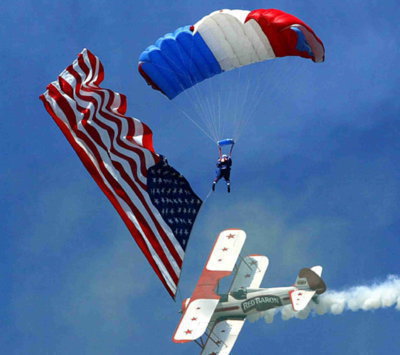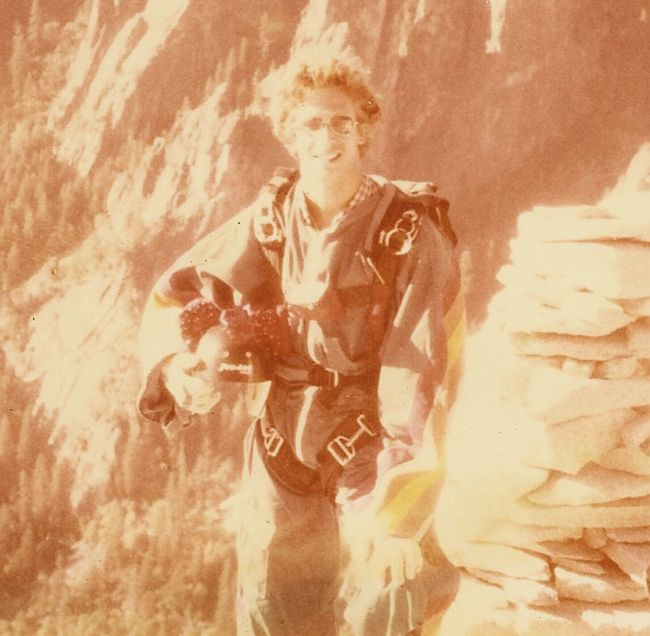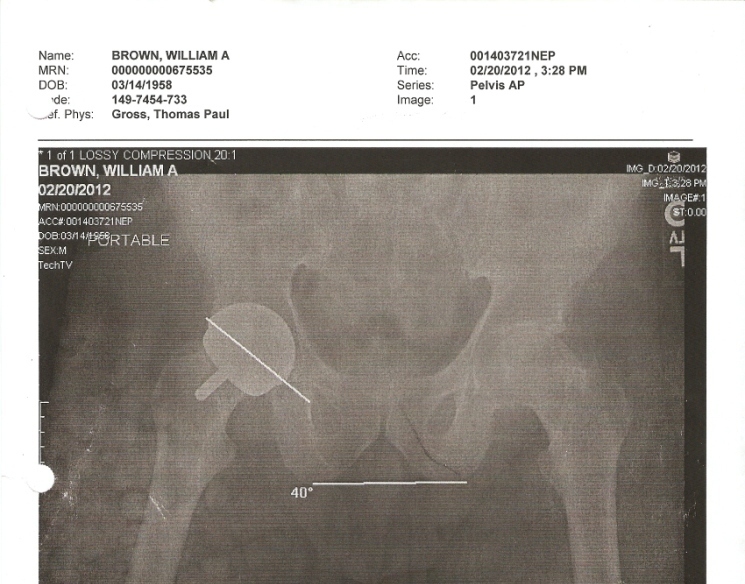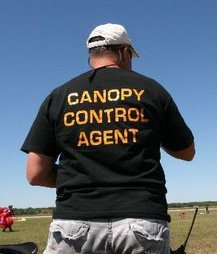Recommended Posts
While jumping a round parachute wouldn't a high pull put the jumper for a longer period of time at the mercy of the winds (making an outside landing more likely)? I wonder if this was also one of the contributing factors for low pulls back in the days?
Either way I still think whoever feels confortable pulling higher should do so and whoever doesn't then go ahead and pull lower. If I have to jump in a big way and have to pull way lower than I am confortable for my skill level then I will just abstain from making that jump in the first place.
QuoteI'd love to find the LIFE Magazine cover shot of the World Record 24 Way round star completed at Perris in 1971. That baby broke off at 3 grand ! Talk about old school, yeah baby !!
Hey Tom, is this the one you were thinking of? It was in Jan. 1972
Sparky
http://i397.photobucket.com/albums/pp55/mjosparky/Skydiving/star24.jpg
QuoteWhile jumping a round parachute wouldn't a high pull put the jumper for a longer period of time at the mercy of the winds (making an outside landing more likely)? I wonder if this was also one of the contributing factors for low pulls back in the days?
Skydivers learned to spot back in the day. Hell they even packed their own shit.
Sparky
Ron 7
QuoteBill Booth's suggestion that the minumum deployment altitude be increased (which sparked this thread) seems to be motivated mostly by the desire to allow AADs to fire a bit higher, saving the small number how had bad outcomes when it fired too low, and to provide more time for a safer emergency landing even for those that fire and deploy as currently expected.
But you have to balance the higher number of two outs that will happen.
The end result is the AAD is a LAST ditch effort if you failed to do anything correctly. I'd venture that the number of people that died because the AAD didn't fire in time is pretty small. And never forget that the jumper had to already screw up several times to get an AAD fire.
You can't make skydiving perfectly safe. The very nature of the sport will not let that happen.
QuoteIOW, I'm trying to figure out the logic of his recommendation, why is it necessary to have USPA recommend a higher level for all jumpers in order to allow AADs to fire higher?
Because if the USPA mandated a higher pull altitude then AAD makers could raise the AAD firing altitude. This would save a small number of people that would not already be saved with the current configurations.
one thing no one is talking about (cypress as its the one I know the best) the 750ft activation is for belly to earth with the unit in your burble, if you back to earth that activation can easily be 1000 to 1100. If you raise the min's of the activation by 500ft, and your unstable you could have an activation by 1600ft. That's pretty damn high for automatic control when you could be still dealing with something.
I agree leave the min's alone, jump the right gear for what you are doing.
sorry Ron didn't really mean it as a reply to you ur just last on the list
jsaxton 0
QuoteI know that Bill Booth is an advocate for this so that the AAD's can be programed to fire at 1100-1200 agl.
Quoteand your unstable you could have an activation by 1600ft. That's pretty damn high for automatic control when you could be still dealing with something.
If you are still dealing with a problem at 1600 feet there’s a good chance we will read about you here sooner or later.
Sparky
Butters 0
QuoteQuoteand your unstable you could have an activation by 1600ft. That's pretty damn high for automatic control when you could be still dealing with something.
If you are still dealing with a problem at 1600 feet there’s a good chance we will read about you here sooner or later.
Sparky
Yeah, even a slow/low puller like me can run through all the standard EP stuff by 1600', still havin' problems below that is when ya start to get creative!
~ If you choke a Smurf, what color does it turn? ~
billvon 2,396
>different level (one they might be more comfortable with), the fact that
>some people use 700ft (or 820 in the Vigil?) and some might be using
>1000 or 1200 wouldn't be a safety concern.
This would be a bad idea for cypreses. Cypreses disarm at 130 feet. If you raise the "ground level" they disarm higher. You could cut away at 1500 feet, not be able to find your reserve, and reach activation speed at 600 feet - just as the cypres disarmed. Given that AAD's are bad at doing this to begin with, and given the number of cutaway/no reserve pull fatalities, it seems like a mistake.
tbrown 26
I AM old school, so before you denounce my manhood or call me a sky socialist, I would like to point out that most people are already pulling higher anyway and that an extra 250 ft on an AAD MIGHT have made a difference at Cross Keys, even though the guy may have already been dead in the air.
Your humble servant.....Professor Gravity !
Ron 7
There is nothing to prevent DZ's from raising their min pull altitudes.
There is nothing to prevent individuals from raising their personal pull altitudes.
Someone already mentioned CYPRES can adjust your altitude for you if you ask.
So everything you want could be done without forcing everyone else to change.
And the point still stands... When do you stop? Having AAD's fire at 1500 feet just has to be safer than 1000 feet. I mean you could fly a normal pattern right? And most people are pulling at 3k anyway right?
An AAD is a backup, yet more and more I see people wanting to change how they skydive to make the AAD happier.
Some do it, like you, to try to make things safer.... Others do it so they can do more dangerous things.
AAD's are a last ditch hail Mary. They seem to be working pretty well for that. No, they will not save everyone, but they have been saving MOST people.
QuoteThe Cross Keys fatality last week would seem a good reason to give this thread a bump. If just a 500 ft increase would give the AAD makers a reason for bumping deployment altitude to 1000 ft, would most dropzones really have a problem with flying 500 ft higher for jump run ?
___________________________________________________
I think they would have a problem because of added cost. There is also a resistance to change so there is always going to be a reason given for not doing it.
I AM old school, so before you denounce my manhood or call me a sky socialist, I would like to point out that most people are already pulling higher anyway and that an extra 250 ft on an AAD MIGHT have made a difference at Cross Keys, even though the guy may have already been dead in the air.
___________________________________________________
I agree
There have been some that have impacted the ground before their canopy had time to fully deploy and it sounds as if this may be one as well. I believe that raising the AAD activation altitude another 250' is reasonable and called for. I would like those who are adamantly against this to propose a better solution. So far all I hear is why this is a bad idea, status quo blah blah blah.
billvon 2,396
>reasonable and called for.
Sure, might make sense for some people.
>I would like those who are adamantly against this to propose a better solution.
Keep it like it is and use an AAD as a last ditch backup instead of an alternate method of deployment. Since many AAD's are adjustable, each person can decide on their own.
QuoteThe Cross Keys fatality last week would seem a good reason to give this thread a bump. If just a 500 ft increase would give the AAD makers a reason for bumping deployment altitude to 1000 ft, would most dropzones really have a problem with flying 500 ft higher for jump run ?
I AM old school, so before you denounce my manhood or call me a sky socialist, I would like to point out that most people are already pulling higher anyway and that an extra 250 ft on an AAD MIGHT have made a difference at Cross Keys, even though the guy may have already been dead in the air.
Sure, if the ADD firing hirer would be the only reason for the reserve to deploy in time and any hesitation was not do to body position, rig design or canopy design.
Personally, I don't think we need to mandate this, individuals can raise their pull altitudes and communicate with the other jumpers on the load and AAD Manufacturers can meet the Industry half way here.
Matt
So, start being safe, first!!!
Quote
There have been some that have impacted the ground before their canopy had time to fully deploy and it sounds as if this may be one as well. I believe that raising the AAD activation altitude another 250' is reasonable and called for. I would like those who are adamantly against this to propose a better solution. So far all I hear is why this is a bad idea, status quo blah blah blah.
I just want to fix what is broken first.
If this is a case of a reserve that should have opened because it was deployed at sufficient altitude with sufficient time, I want us to address that problem.
If this was a rig that could tow the reserve pilot chute to the ground even though it was opened with sufficient time and altitude available, then raising the AAD altitude might not help.
That is a lot of "ifs", I know.
And I don't really know that these "ifs" are pertinent to this incident.
But in the case that they are, that's where I want the first focus.
Because we all expect and deserve that the reserves on our backs should perform according to the requirements set forth for them.
If they are not, we need to fix that first.
If, after establishing that we have gear that meets the specs, we are still left with cases where an extra second would have made a difference, then by all means, let's look at that too.
Keep it like it is and use an AAD as a last ditch backup instead of an alternate method of deployment. Since many AAD's are adjustable, each person can decide on their own.
Status Quo
QuoteQuote
There have been some that have impacted the ground before their canopy had time to fully deploy and it sounds as if this may be one as well. I believe that raising the AAD activation altitude another 250' is reasonable and called for. I would like those who are adamantly against this to propose a better solution. So far all I hear is why this is a bad idea, status quo blah blah blah.
I just want to fix what is broken first.
.
.
.
If, after establishing that we have gear that meets the specs, we are still left with cases where an extra second would have made a difference, then by all means, let's look at that too.
Dang it. Every time I have a sensible post, you beat me to it.
Some are already blaming activation altitude when, in fact, we don't know that yet, do we?
Can anyone point to incidents that the AAD did NOT activate when the parameters were met?
Now compare that number to how many times it DID.
Always keep in mind that what happens after activation is independent.
I think we're all Bozos on this bus.
Falcon5232, SCS8170, SCSA353, POPS9398, DS239







.thumb.jpg.4bb795e2eaf21b8b300039a5e1ec7f92.jpg)



I don't think AFF is to blame for that type of attitude towards pull altitudes. Most AFF programs I know of (or ISP, or whatever) steadily lower the pull altitude to 3500' or so by the time the jumper is done with their A license card.
The problem lies in the fact that skydiving has become more accessible to more people over the years. It's not the physical challenge it used to be to become a skydiver. No round canopies, no belly-mounts, sometimes never cramped into a Cessna for 35 min, no packing in the sun, just paid packers, air conditioned hang-out areas, and roomy, quick rides to altitude all day long.
So what you end up with is a segment of jumpers who never would have made the cut in years past, but since everything has gone all touchy-feely, and everyone can (supposedly) be trained, you have some different types of people who make it through the ranks.
The caveat to that is that your friend is right. If she is not confident in her ability to react swiftly and without fail at pull time, and whatever follows, then intiating the pull higher will buy her more time to deal with whatever comes.
Just because you (and me) and others see no problem with the alloted time a lower pull altitude offers you to get a good canopy over your head, doesn't mean that others share that opinion, and the simple fact is that pulling higher does result in more time to deal with it.
So while I share your frustration that skydiving has allowed it's ranks to be joined by those who maybe shouldn't be there, I won't fault those people when the make a sound decision like being realistic about their abilities, and not being pressured into pushing themselves beyond their comfort zone. It's true that I'm of the opinion that those people are making a mistake by jumping in the first place, but that doesn't make following one mistake with another a good idea.
Share this post
Link to post
Share on other sites